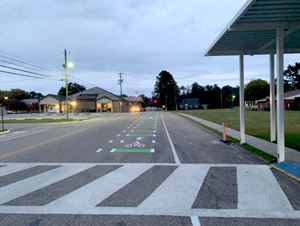ALProHealth
- Need: To improve access to healthy food and physical activity in rural Alabama.
- Intervention: Researchers hold focus groups with community members to identify issues of the most concern and then help them implement appropriate interventions like installing playground equipment.
- Results: From 2014 to 2018, 14 coalitions implemented 101 interventions in 16 communities.
Evidence-level
Promising (About evidence-level criteria)Description
According to America's Health Rankings, in 2022, 31.5% of people in Alabama reported no physical activity outside of work in the last 30 days, compared to a national rate of 23.7%. In addition, many rural communities don't have safe places to walk or ride bicycles, which limits people's ability to exercise.
The Alabama Cooperative Extension System uses community-based participatory research to help coalitions of community members increase opportunities and improve spaces for physical activity and access to healthier foods in their rural communities. Coalitions decide on and implement research-based interventions related to built environment, healthier retail options for food, and physical activity opportunities.
ALProHealth currently reaches 13 rural counties with high rates of obesity and is funded by the Centers for Disease Control and Prevention (CDC) High Obesity Program grant.
To learn more about ALProHealth, please watch this 5-minute video:
Services offered
Researchers hold focus groups, with 10-15 participants and lasting 1-3 hours each. The facilitator asks questions concerning nutrition education, access to healthy food, and opportunities for physical activity. The facilitator also posts a map of the community on the wall so participants can better visualize the community and identify specific locations being discussed.
After the focus groups, Alabama Extension provides community coalitions with recommendations to alleviate previously discussed barriers. Coalition members then choose which interventions to implement based on what works best for their unique population and environment.
Results

From 2014 to 2018, 14 coalitions implemented 101 interventions in 16 communities, including adding playground equipment, installing water fountains and lighting along trails, and promoting existing physical activity facilities. For example, the rural community of Linden made one of its streets safer for pedestrians and cyclists by narrowing the vehicle travel lanes, striping new buffered bike lanes on either side, and adding new crossings and lighting. Other examples include Barbour and Henry counties adding healthier snacks to vending machines.
For more information:
Carter, W.M., Morse, W.C., Brock, R.W., & Struempler, B. (2019). Improving Physical Activity and Outdoor Recreation in Rural Alabama Through Community Coalitions. Preventing Chronic Disease, 16, E116. Article Abstract
Challenges
Increasing access to healthier foods and opportunities for safe and affordable physical activity is often a long and expensive endeavor. While funding is a challenge, public perception and acceptance of the initiative can be one of the largest barriers for making healthy changes in communities. Oftentimes, the best way to advocate for long-lasting change is to demonstrate opportunities at a small scale to build momentum for investing in larger systemic and policy changes.
Successful implementation of the ALProHealth initiative is dependent upon effective community coalitions. Residents provide the local knowledge that is key to making informed, research-based decisions about the best ways to solve local problems.
Replication
One of the greatest contributors to success of this initiative is the infrastructure of Cooperative Extension. Because there is an Extension office in every county in Alabama, County Extension Coordinators are familiar with local issues and know the appropriate stakeholders and community members who can assemble to solve local issues.
Contact Information
Ruth W. Brock, MEd, Extension SpecialistAlabama Cooperative Extension System – Family and Consumer Sciences
rlw0031@auburn.edu
Topics
Community and faith-based initiatives
· Food security and nutrition
· Infrastructure
· Obesity and weight control
· Physical activity
States served
Alabama
Date added
March 25, 2022
Suggested citation: Rural Health Information Hub, 2023 . ALProHealth [online]. Rural Health Information Hub. Available at: https://www.ruralhealthinfo.org/project-examples/1097 [Accessed 25 October 2025]
Please contact the models and innovations contact directly for the most complete and current information about this program. Summaries of models and innovations are provided by RHIhub for your convenience. The programs described are not endorsed by RHIhub or by the Federal Office of Rural Health Policy. Each rural community should consider whether a particular project or approach is a good match for their community’s needs and capacity. While it is sometimes possible to adapt program components to match your resources, keep in mind that changes to the program design may impact results.
